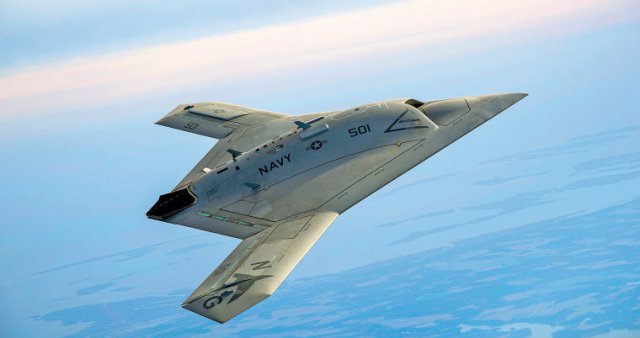A test to prove an autonomous unmanned aerial vehicle (UAV) can be refuelled in flight could happen by the end of this month, according to officials with Naval Air Systems Command.
The test would pair a Northrop Grumman X-47B Unmanned Combat Air System demonstrator (UCAS-D) with a contracted tanker to prove out software that could allow future unmanned aerial vehicles (UAV) to be autonomously aerially refuelled (AAR) in the same way the Navy’s current crop of carrier aircraft can take on fuel from tanker aircraft.
The effort is part of a June $64 million testing contract with Northrop that was set to expire in March.
A NAVAIR spokeswoman told USNI News the “team was managing the contract to allow for AAR flights by the end of the month.”
One of the two X-47Bs — Salty Dog 502 — is plumbed to take on fuel by a so-called probe-and-drouge aerial refueling system in which a fuel line is feed out behind the tanker and meets a probe on the receiving aircraft.
USNI News understands that — with modifications — Salty Dog 502 can receive fuel from the Air Force flying boom refueling method as well.
NAVAIR will use a contracted Omega Aerial Refuelling Services tanker for the test, Military.com reported last week.
On Thursday, NAVAIR conducted a successful non-contact test flight between a tanker and a X-47B.
The AAR software has been tested successfully on surrogate aircraft before the current round of testing.
Continued test flights of the X-47B come as the Pentagon reviews the range of UAVs in its portfolio that will inform the character of the Navy’s Unmanned Carrier Launched Surveillance and Strike (UCLASS) program.
AAR for UCLASS has been a lingering issue for the Navy as debate on whether or not the final air segment of the program needs the capability continues.
A more efficient air frame for a surveillance oriented UCLASS would eschew the need for aerial refueling while a more lethal aircraft capable of penetrating enemy air defense networks would trade efficiency for payload and stealth characteristics.
“The current trajectory for the Navy program was 14-plus hours of unrefuelled endurance, which then forces you to compromise on payload as well as on signature reduction,” Robert Martinage, former Department of the Navy under secretary and currently with the Center for Strategic and Budgetary assessments told National Defense Magazine in December.
“If the aircraft is capable of air-to-air refuelling, the argument in favour of really long unrefuelled organic range — 14 hours plus — is weakened.”
Source: USNI News

